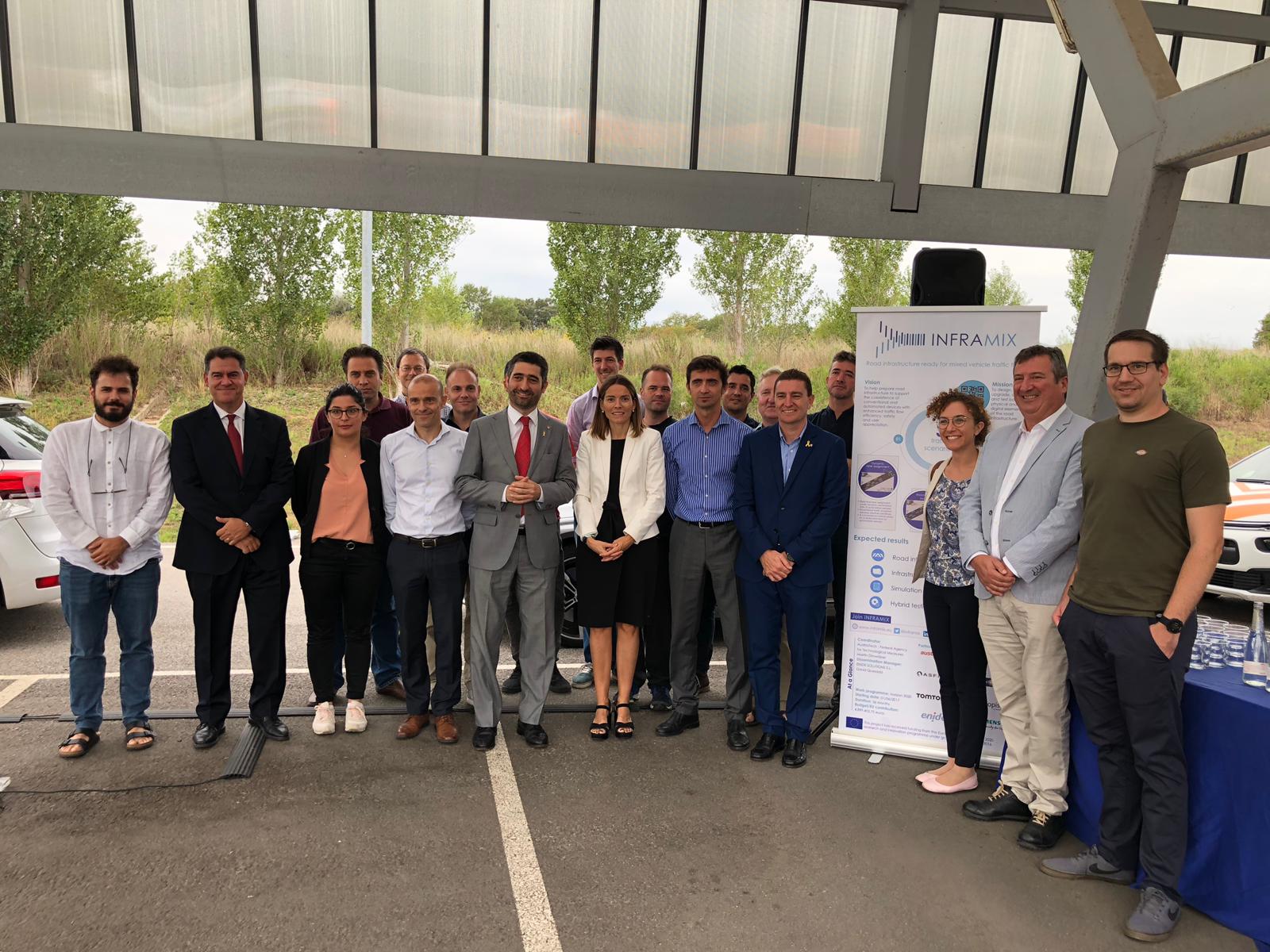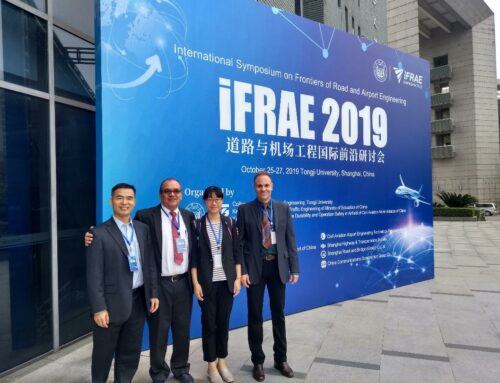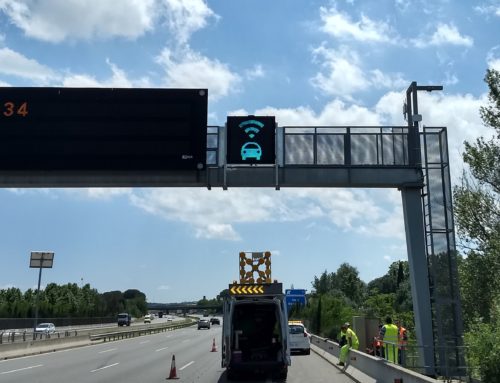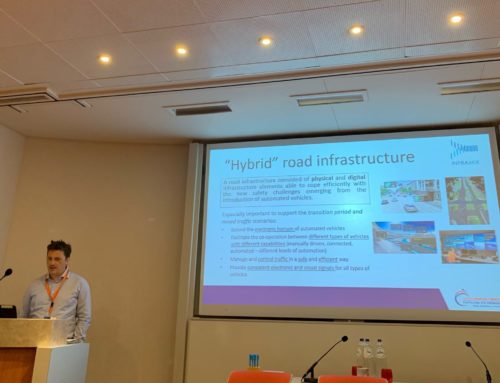We met the INFRAMIX partners David Porcuna, from ABERTIS AUTOPISTAS ESPAÑA, S.A. and Yannick Wimmer, from ASFINAG and discussed together about the testing days in Girona and Graz.
Why is INFRAMIX so interesting?
We tried to find out why INFRAMIX is so important and interesting for AUTOPISTAS and ASFINAG as road authority and road operator respectively. David Porcuna highlighted that the project’s main target is to design, upgrade, adapt and test (in simulation and in real-world) both physical and digital elements of the road infrastructure, to enable the coexistence of automated and conventional vehicles, in specific scenarios, ensuring an uninterrupted, predictable, safe and efficient traffic. The key outcome will be a “hybrid” road infrastructure able to handle the transition period and become the basis for future automated transport systems. “In consequence of this target, the enrichment of the information acquired by the infrastructure will clearly have an impact on the already identified future business. In a longer-term, we see the possibility of offering new services based on the hybrid infrastructure approach developed in INFRAMIX”, he commented. From ASFINAG, Yannick Wimmer underlined that “the penetration rate of connected and automated vehicles will steadily increase over the next years on the ASFINAG road network. Therefore, ASFINAG is highly interested in R&D projects like INFRAMIX, which are targeting this topic.”
What are the INFRAMIX scenarios and how do they help reach the project objectives?
David Porcuna briefly presented the main features of the three scenarios to be studied within INFRAMIX.
Scenario 1 – Dynamic lane assignment (incl. speed recommendations). The target of this scenario is to cater for mixed traffic on normal multilane highway segments by assigning dynamically one (or more) lanes to automated traffic; either isolated automated vehicles or automated vehicles forming platoons. During this process, parameters such as the penetration rate of automated vehicles and the prevailing traffic conditions will be considered. In addition, speed limits per lane or road segment will be dynamically adapted taking into account also potential adverse weather conditions.
Scenario 2 – Construction site / Roadworks zones. Roadworks zones are major safety hotspots with many accidents both for vehicles and for the staff on site. They pose interesting challenges for efficient coordination of mixed traffic flows, where the infrastructure should help the vehicles by providing extended information in real-time like updated maps, additional traffic signs, reference points on the spot for accurate localization for automated vehicles, new traffic control measures, etc. in the particular region. Both the physical and digital infrastructure should be prepared to accommodate such situations.
Scenario 3 – Bottlenecks. The scope of this scenario is to investigate real-time controllers, involving a variety of control measures, such as dynamic speed limits, merge assistance and ramp metering, to manage mixed traffic situations in front of bottlenecks of various kinds (on-ramps, off-ramps, lane drops, tunnels, bridges, sags) and avoid traffic flow degradation.
As he explained, these three scenarios are relevant for Abertis Autopistas as a Road Operator because it can offer its knowledge to improve the current situation. Today there are several initiatives demonstrating automated driving activities and driverless vehicles focusing on the vehicle and the driver, but typically neglecting the resulting traffic flow implications and the role of the infrastructure. “The above-mentioned scenarios are important as they will enable to understand the requirements and needs of the mixed traffic of the future”, added Yannick Wimmer.
What challenges do the INFRAMIX scenarios meet?
“Currently the INFRAMIX scenarios have been tested in real-life environments, but the penetration rate of connected and especially automated vehicles on the road network is still close to 0.” Yannick Wimmer explained. Moreover, David Porcuna added: “the coexistence of automated and conventional vehicles could lead to confusing and potentially unsafe situations, among other things, due to the unforeseeable human driving. Road infrastructure will play a major role in managing this transition period in order to make the introduction of automated vehicles on the roads faster, smoother, safer, acceptable and socially beneficial for all traffic participants“.
How can road operators and road authorities benefit from the improved scenarios?
Among the main benefits deriving from the improved scenarios, Yannick Wimmer mentioned the improvement of traffic control strategies and of communication strategies. On the other hand, David Porcuna highlighted the specific affordable adaptations to accommodate a step-wise introduction of automated vehicles. In addition, he underlined the need for intelligent, incremental and adaptable interventions in the infrastructure that take advantage of the innovative vehicle developments and interact with them. “Infrastructure upgrade is a slower process than vehicle automation developments. The average vehicle age is about 10 years, whereas the average lifecycle of the road is 20 to 30 years. This strong mismatch does not allow infrastructure to follow the new developments in automated vehicles. At the same time building new roads or severely upgrading existing ones is a quite long and costly procedure”, he explained. Furthermore, according to David, new and existing physical or digital infrastructure elements need to be designed and adapted in order to allow the current infrastructure to address the introduction of automation in a flexible, fast and cost-effective way while being understood by all traffic participants, automated or not. This will lead to a “hybrid” infrastructure able to cope efficiently with the new safety challenges emerging from the introduction of automated vehicles, especially within the transition period.
What are the next steps?
Regarding the next steps of Abertis Autopistas in INFRAMIX, David Porcuna said “After performing the test in a satisfactory way, the analysis of the data and the appreciation of the different partners will be necessary in order to work on the system integration and testing. Of course, an additional deliverable with the evaluation, the users’ appreciation and the safety performance will be necessary. At the end of the project, Abertis Autopistas will collaborate and participate actively in the communication, dissemination and exploitation plans of INFRAMIX.”
What will happen at the end of INFRAMIX?
Regarding the actions that road authorities should take after INFRAMIX, both partners agreed that INFRAMIX is a good opportunity to be prepared for the upcoming developments, i.e. the mixed traffic flows that are approaching. More specifically, David Porcuna listed:
- the specification and elaboration of proposals for standardization of the bidirectional communication and related messages between the road infrastructure and automated vehicles is a major step towards the smooth integration of automated vehicles of different levels of automation in today’s transport networks. By basing speed, lane, and route recommendations on both data from the vehicle fleet and the road operator, INFRAMIX will enlarge the electronic road horizon of automated vehicles and will be a first-of-its-kind implementation of the “Traffic Management 2.0” approach. It will demonstrate that the goal of public and private actors in traffic can be coordinated and that win-win situations can be created.
- the design and development of digital infrastructure, consistent with the physical one, will play a key role in the successful and timely introduction of automated vehicles on our roads. This is especially important for the transition period where the investments on physical roads will be limited. INFRAMIX proposes minimum required adaptations and upgrades to the infrastructure side and new traffic signs for guiding road participants, strongly reducing or eliminating the need for expensive gantries and spot sensors. The proposed solutions will lead more road operators to understand and to invest, thus creating a leap for European roads towards automation.
- The novel approach of hybrid testing has further high innovation potential. Coupling infrastructure elements and vehicles on real roads with virtual traffic environment allows the testing of the full information chain between vehicle and traffic management system. Road operators, on the other hand, will have the possibility to evaluate and optimize infrastructure and traffic control measures considering real-time communication with real vehicles. This will help to timely prepare the infrastructure for future uninterrupted mixed traffic.
- Another important concept promoted by INFRAMIX is the infrastructure classification scheme. The work about this scheme will make road infrastructure owners and operators more involved in the discussion regarding automation and be more active and supportive of the early adoption of automated vehicles. All the above-mentioned developments offered by INFRAMIX will boost EU innovation in Automated Road Transport.
You can find more information about INFRAMIX testing days in the dedicated page about INFRAMIX test sites. You can meet David Porcuna and Yannick Wimmer on our Linkedin group .






